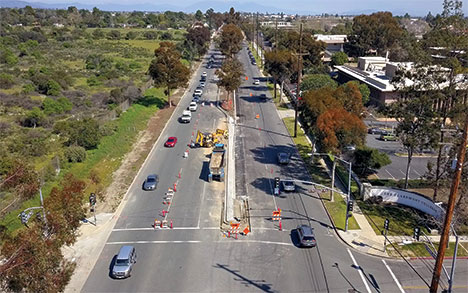Foothill facelift will impact traffic through 2019

The Foothill Boulevard improvement project is moving along, and it is about 20 percent complete, the city says.
The news comes from Claremont assistant engineer Vincent Ramos, who gave a status update during last week’s city council meeting.
The project is a yearlong facelift of Claremont’s main east-west thoroughfare. Elements of the project include protected bike lanes, new drought-tolerant landscaping, bioswales in the medians to capture storm water and new bus stops. The project began in October 2018 and is expected to last throughout 2019.
City Manager Tara Schultz told the council the update was in response to residents’ questions about the $16 million project, which is funded mostly through grants, including a $7 million gas tax grant. The city stressed that no general fund money is being used on the project.
“Because we had so many inquiries and concerns raised by community members, I thought it would be really good to have this update so people know where we’re at, what we’re doing,” she said.
The project has been separated into four phases. Phase one—which runs west from Monte Vista Avenue to Amherst Avenue—is ab
Phase two, which stretches from Amherst Avenue to Yale Avenue, is well underway, with construction starting on March 5, Mr. Ramos said.
Phase three—from Yale to Mountain Avenue—is slated to begin on June 3 and will take three months to complete. Phase four—from Mountain Avenue to Towne Avenue—will begin in September and will take just a month to complete.
Final paving will be completed in December, if all goes forward as planned. Initially, the project had a November due date, but it has been delayed by a month due to a combination of rainy days and holidays, the city said.
Mr. Ramos touched upon several topics and questions brought forth by residents thus far. One was the apparent perception from some residents that the extra-wide lanes of Foothill Boulevard that Claremonters were used to would be narrowed to one lane.
This was untrue, Mr. Ramos said—each direction will have two 12-foot wide lanes, the same length as Arrow Highway and Base Line Road.
Mayor Pro Tem Larry Schroeder later added that 12-foot length is also the width of freeway lanes.
Sidewalks along the thoroughfare will be anywhere from five to eight feet wide, he added.
Mr. Ramos also touched on a controversial aspect of the plan—the stone street signs along Foothill’s medians. Some residents, including Claremont Heritage, were in an uproar a few weeks ago when one of the Mills Avenue signs was taken out during construction.
Of the seventeen total street signs, eight of them are going to be preserved, Mr. Ramos said. The other signs “do potentially conflict with the new roadway layout,” Mr. Ramos said, meaning they won’t fit in the new median design. But after working with Claremont Heritage, the city reached a compromise: shifting the signs back or forth on the median to make them fit, or relocating them entirely to another part of town.
“If they can’t be shifted or moved at once, as a last resort we will reconstruct and rebuild them to match in kind,” Mr. Ramos said.
A contractor attempted to relocate the Mills Avenue sign, he said, but it began to fall apart from the foundation and thus was not salvageable. That sign will be reconstructed, Mr. Ramos said.
One of those signs at College Avenue has been successfully shifted, he added.
Two had been previously damaged in vehicle collisions and were never replaced—one at Towne Avenue and another at Yale Avenue.
Trees are of continued concern during the project, Mr. Ramos said. While the city has implemented “tree protection zones” around each existing tree, one tree has been lost in the process.
According to Mr. Ramos, a backhoe operator accidentally damaged “a sizeable tree root” belonging to a tree on one of the median areas. The tree eventually had to be removed.
Councilmember Ed Reece inquired about the recourse for that lost tree. Mr. Ramos said the city could collect damages from that contractor, but won’t make a decision until a final report is completed.
“Until I have seen the final report, I’m still waiting,” Mr. Ramos said.










0 Comments